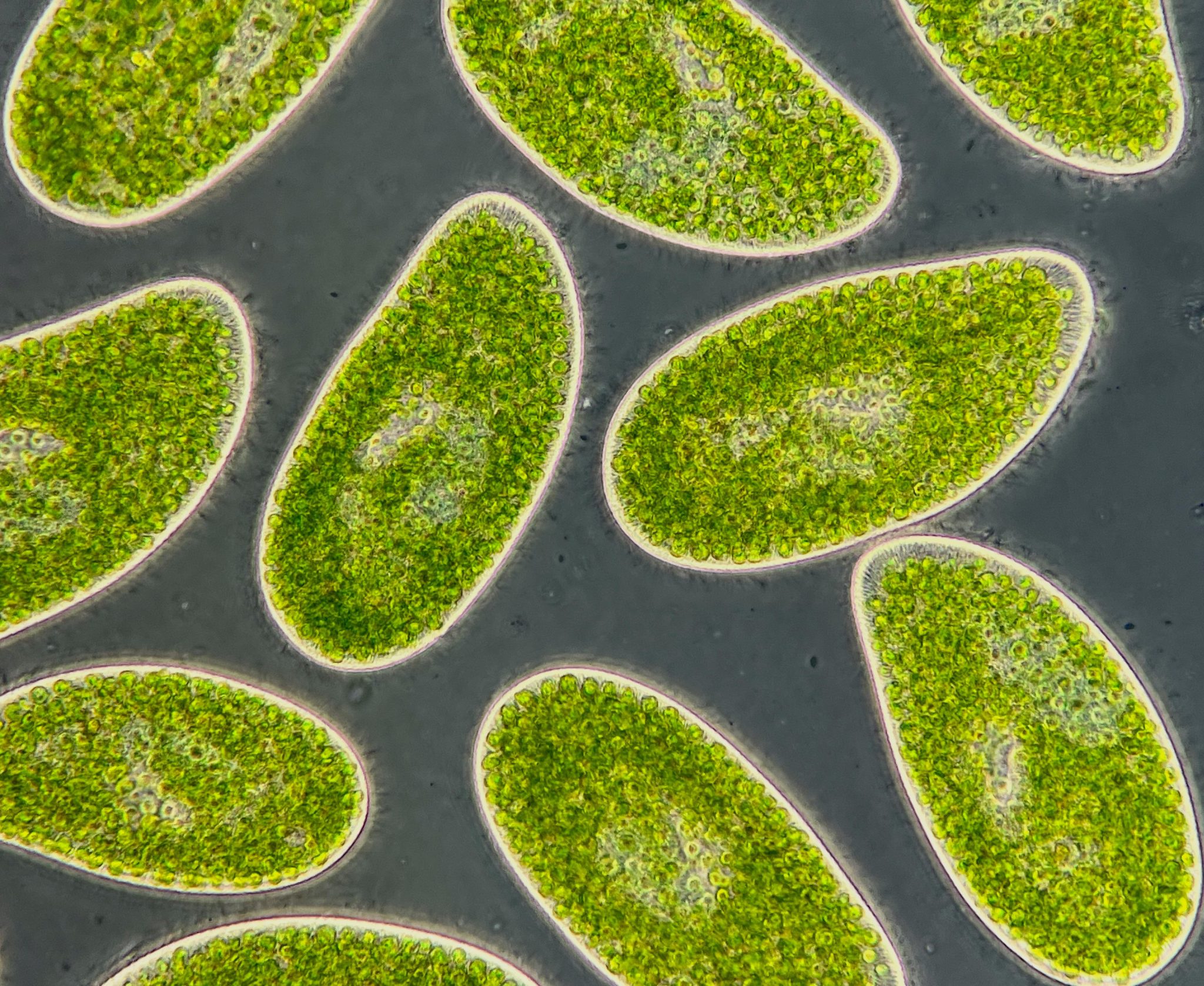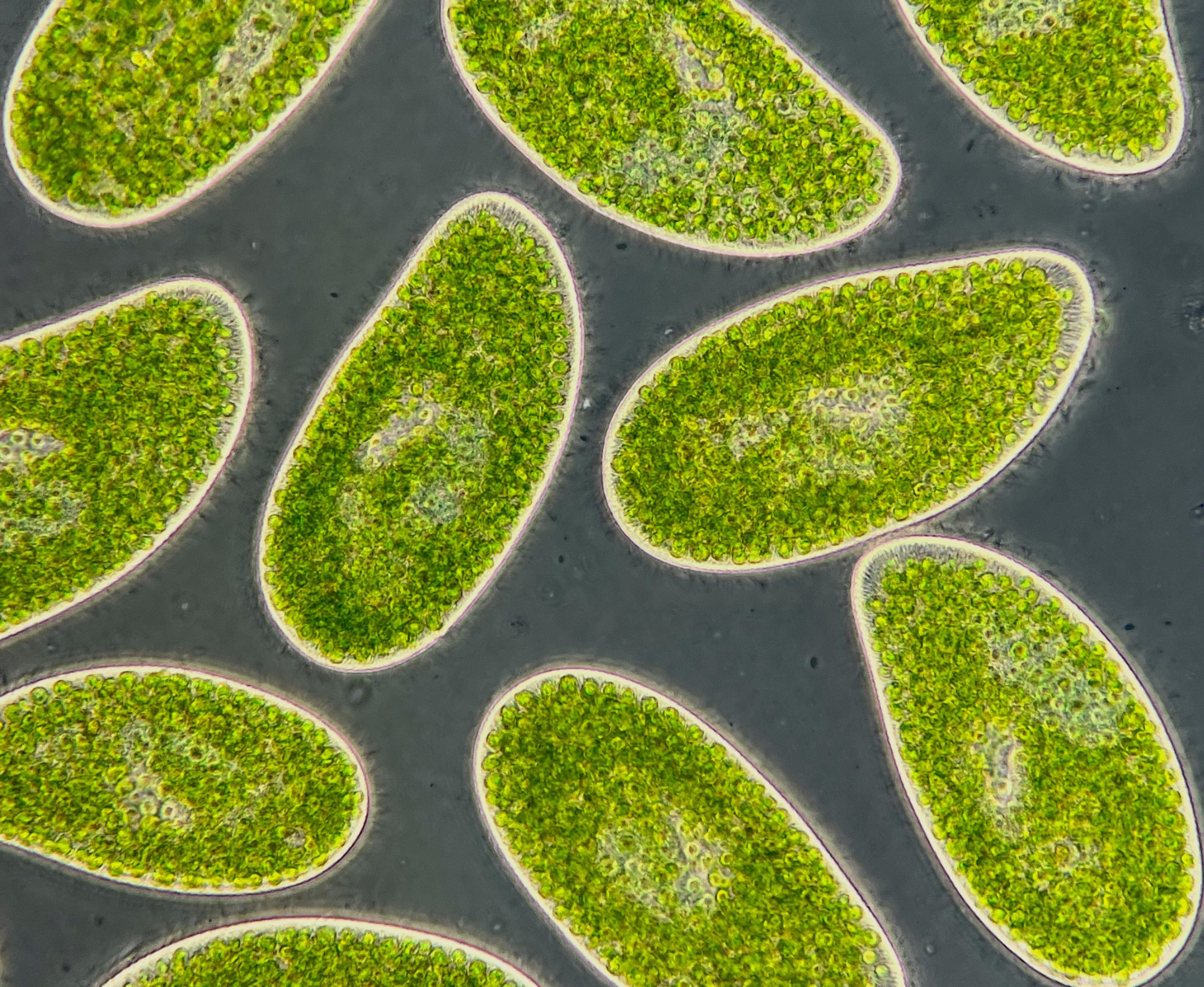
توجد هذه الكائنات وحيدة الخلية في البحيرات والأنهار حول العالم Paramecium bursaria يمكن أن تأكل والقيام بعملية التمثيل الضوئي. تلعب الميكروبات مثل هذه دورًا مزدوجًا في تغير المناخ ، حيث تطلق أو تمتص ثاني أكسيد الكربون – غاز الاحتباس الحراري الذي يحبس الحرارة والذي يعد المحرك الأساسي للاحترار – سواء كانت تعتمد على نمط حياة شبيه بالحيوان أو نمط حياة شبيه بالنباتات. الائتمان: دانيال ج. Wysinski ، جامعة ديوك
قد تؤدي زيادة مستويات الحرارة إلى دفع العوالق البحرية والكائنات وحيدة الخلية الأخرى نحو عتبة الكربون ، مما قد يؤدي إلى تفاقم ظاهرة الاحتباس الحراري. ومع ذلك ، تشير الدراسات الحديثة إلى أنه قد يكون من الممكن تحديد علامات الإنذار المبكر قبل أن تصل هذه الكائنات الحية إلى تلك المرحلة الحرجة.
اكتشف فريق من العلماء الباحثين في الميكروبات المنتشرة والتي غالبًا ما يتم تجاهلها حلقة ردود فعل مناخية يمكن أن تزيد من الاحتباس الحراري. ومع ذلك ، تأتي هذه النتيجة مع جانب إيجابي: فقد تكون أيضًا إشارة تحذير مبكر.
باستخدام محاكاة الكمبيوتر ، أظهر باحثون من جامعة ديوك وجامعة كاليفورنيا ، سانتا باربرا أن المحيط العالمي قد يصل إلى نقطة تحول مع العوالق ، وعدد كبير من الكائنات وحيدة الخلية التي تعيش في البحيرات وأراضي الخث والنظم البيئية الأخرى. هنا ، بدلاً من امتصاص ثاني أكسيد الكربون ، يبدأون في فعل العكس. هذا التغيير هو نتيجة للطريقة التي يستجيب بها التمثيل الغذائي للاحترار.
لأن ثاني أكسيد الكربون هو غاز من غازات الدفيئة ، فإنه يمكن أن يزيد درجات الحرارة – حلقة تغذية مرتدة إيجابية ، حيث الكميات الصغيرة من الاحترار يمكن أن يكون لها تأثير كبير.
لكن من خلال مراقبة وفرة هذه الأنواع بعناية ، يمكننا توقع نقطة التحول قبل أن تصل إلى هنا ، حسبما أفاد الباحثون في دراسة نُشرت في 1 يونيو في المجلة. علم البيئة الوظيفية.
في الدراسة الجديدة ، ركز الباحثون على مجموعة من الكائنات الدقيقة تسمى mixotrophs ، سميت بهذا الاسم لأنها تمزج بين وضعي التمثيل الغذائي: يمكنهم إما التمثيل الضوئي مثل النبات أو البحث عن طعام مثل الحيوان ، اعتمادًا على الظروف.
“مثلهم[{” attribute=””>Venus fly traps of the microbial world,” said first author Daniel Wieczynski, a postdoctoral associate at Duke.
During photosynthesis, they soak up carbon dioxide, a heat-trapping greenhouse gas. And when they eat, they release carbon dioxide. These versatile organisms aren’t considered in most models of global warming, yet they play an important role in regulating climate, said senior author Jean P. Gibert of Duke.
Most of the plankton in the ocean — things like diatoms, dinoflagellates — are mixotrophs. They’re also common in lakes, peatlands, in damp soils, and beneath fallen leaves.
“If you were to go to the nearest pond or lake and scoop a cup of water and put it under a microscope, you’d likely find thousands or even millions of mixotrophic microbes swimming around,” Wieczynski said.
“Because mixotrophs can both capture and emit carbon dioxide, they’re like ‘switches’ that could either help reduce climate change or make it worse,” said co-author Holly Moeller, an assistant professor at the University of California, Santa Barbara.
To understand how these impacts might scale up, the researchers developed a mathematical model to predict how mixotrophs might shift between different modes of metabolism as the climate continues to warm.
The researchers ran their models using a 4-degree span of temperatures, from 19 to 23 degrees Celsius (66-73 degrees Fahrenheit). Global temperatures are likely to surge 1.5 degrees Celsius above pre-industrial levels within the next five years, and are on pace to breach 2 to 4 degrees before the end of this century.
The analysis showed that the warmer it gets, the more mixotrophs rely on eating food rather than making their own via photosynthesis. As they do, they shift the balance between carbon in and carbon out.
The models suggest that, eventually, we could see these microbes reach a tipping point — a threshold beyond which they suddenly flip from carbon sink to carbon source, having a net warming effect instead of a cooling one.
This tipping point is hard to undo. Once they cross that threshold, it would take significant cooling — more than one degree Celsius — to restore their cooling effects, the findings suggest.
But it’s not all bad news, the researchers said. Their results also suggest that it may be possible to spot these shifts in advance, if we watch out for changes in mixotroph abundance over time.
“Right before a tipping point, their abundances suddenly start to fluctuate wildly,” Wieczynski said. “If you went out in nature and you saw a sudden change from relatively steady abundances to rapid fluctuations, you would know it’s coming.”
Whether the early warning signal is detectable, however, may depend on another key factor revealed by the study: nutrient pollution.
Discharges from wastewater treatment facilities and runoff from farms and lawns laced with chemical fertilizers and animal waste can send nutrients like nitrate and phosphate into lakes and streams and coastal waters.
When Wieczynski and his colleagues included higher amounts of such nutrients in their models, they found that the range of temperatures over which the telltale fluctuations occur starts to shrink until eventually the signal disappears and the tipping point arrives with no apparent warning.
The predictions of the model still need to be verified with real-world observations, but they “highlight the value of investing in early detection,” Moeller said.
“Tipping points can be short-lived, and thus hard to catch,” Gibert said. “This paper provides us with a search image, something to look out for, and makes those tipping points — as fleeting as they may be — more likely to be found.”
Reference: “Mixotrophic microbes create carbon tipping points under warming” by Daniel J. Wieczynski, Holly V. Moeller and Jean P. Gibert, 31 May 2023, Functional Ecology.
DOI: 10.1111/1365-2435.14350
The study was funded by the Simons Foundation, the National Science Foundation, and the U.S. Department of Energy.

“متعصب للموسيقى. مستكشف متواضع جدا. محلل. متعصب للسفر. مدرس تلفزيوني متطرف. لاعب.”

